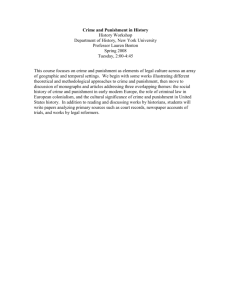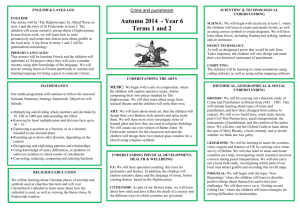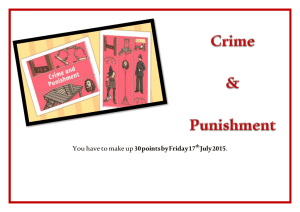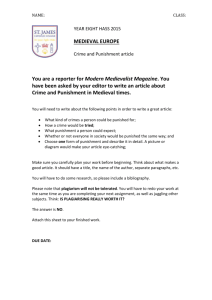PUNISHMENT IN SOCIETY - University of California at Berkeley
advertisement
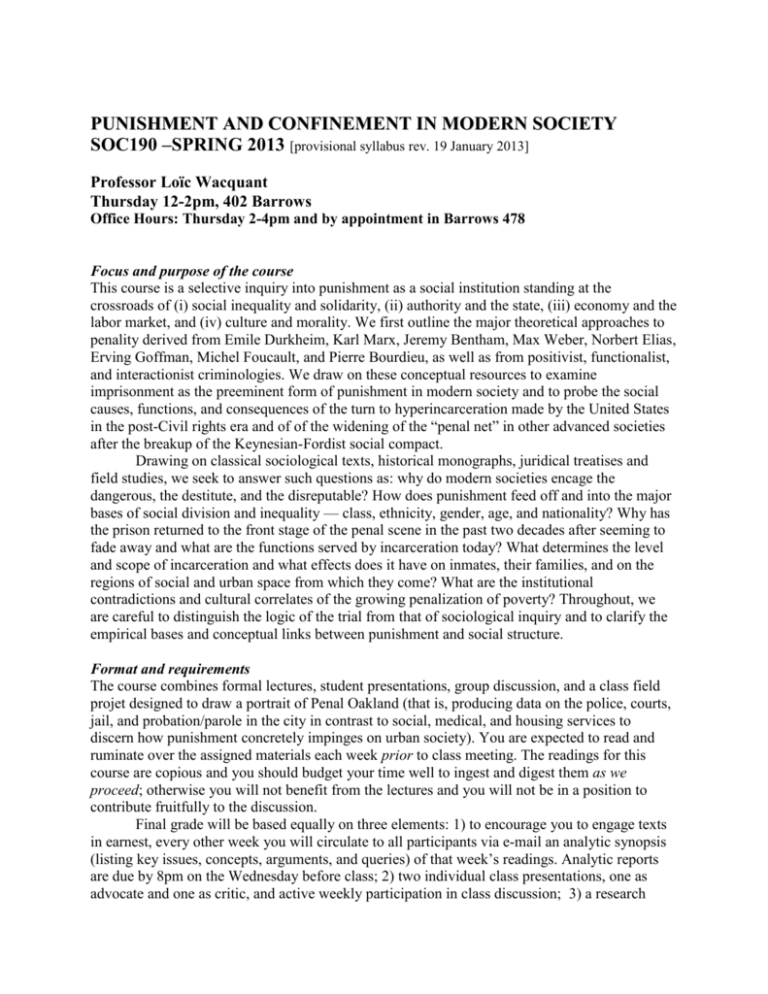
PUNISHMENT AND CONFINEMENT IN MODERN SOCIETY SOC190 –SPRING 2013 [provisional syllabus rev. 19 January 2013] Professor Loïc Wacquant Thursday 12-2pm, 402 Barrows Office Hours: Thursday 2-4pm and by appointment in Barrows 478 Focus and purpose of the course This course is a selective inquiry into punishment as a social institution standing at the crossroads of (i) social inequality and solidarity, (ii) authority and the state, (iii) economy and the labor market, and (iv) culture and morality. We first outline the major theoretical approaches to penality derived from Emile Durkheim, Karl Marx, Jeremy Bentham, Max Weber, Norbert Elias, Erving Goffman, Michel Foucault, and Pierre Bourdieu, as well as from positivist, functionalist, and interactionist criminologies. We draw on these conceptual resources to examine imprisonment as the preeminent form of punishment in modern society and to probe the social causes, functions, and consequences of the turn to hyperincarceration made by the United States in the post-Civil rights era and of of the widening of the “penal net” in other advanced societies after the breakup of the Keynesian-Fordist social compact. Drawing on classical sociological texts, historical monographs, juridical treatises and field studies, we seek to answer such questions as: why do modern societies encage the dangerous, the destitute, and the disreputable? How does punishment feed off and into the major bases of social division and inequality — class, ethnicity, gender, age, and nationality? Why has the prison returned to the front stage of the penal scene in the past two decades after seeming to fade away and what are the functions served by incarceration today? What determines the level and scope of incarceration and what effects does it have on inmates, their families, and on the regions of social and urban space from which they come? What are the institutional contradictions and cultural correlates of the growing penalization of poverty? Throughout, we are careful to distinguish the logic of the trial from that of sociological inquiry and to clarify the empirical bases and conceptual links between punishment and social structure. Format and requirements The course combines formal lectures, student presentations, group discussion, and a class field projet designed to draw a portrait of Penal Oakland (that is, producing data on the police, courts, jail, and probation/parole in the city in contrast to social, medical, and housing services to discern how punishment concretely impinges on urban society). You are expected to read and ruminate over the assigned materials each week prior to class meeting. The readings for this course are copious and you should budget your time well to ingest and digest them as we proceed; otherwise you will not benefit from the lectures and you will not be in a position to contribute fruitfully to the discussion. Final grade will be based equally on three elements: 1) to encourage you to engage texts in earnest, every other week you will circulate to all participants via e-mail an analytic synopsis (listing key issues, concepts, arguments, and queries) of that week’s readings. Analytic reports are due by 8pm on the Wednesday before class; 2) two individual class presentations, one as advocate and one as critic, and active weekly participation in class discussion; 3) a research 2 module leading to a 10-page report on one facet of contemporary punishment integrated with the Penal Oakland class project; this report is due imperatively on Tuesday 7 May. Note that there will be no exceptions or extensions, so plan your work schedule accordingly. Pending final arrangements, the class will do one field visit to Santa Rita jail or San Quentin state prison. The required books are available from the usual bookstores. The other assignments are available available on the course page of BSPACE. All readings are also on reserve at Moffitt Library. Required books Comfort, Megan. 2008. Doing Time Together: Love and Family in the Shadow of the Prison. Chicago: University of Chicago Press. Foucault, Michel. [1975]. 1977. Discipline and Punish: The Birth of the Prison. New York: Pantheon. Irwin, John. 1984. The Jail: Managing the Underclass in American Society. Berkeley: University of California Press. Lukes, Stephen and Andrew Scull (eds.). 1995. Durkheim and the Law. Stanford: Stanford University Press. Spierenburg, Peter. 1984. The Spectacle of Suffering : Executions and the Evolution of Repression, From a Preindustrial Metropolis to the European Experience. Cambridge: Cambridge University Press (new ed. 2008). Rios, Victor M. 2011. Punished: Policing the Lives of Black and Latino Boys. New York: NYU Press. Sykes, Gresham. 1958. The Society of Captives: A Study in a Maximum Security Prison. Princeton: Princeton University Press, 1974. Tonry, Michael. 1995. Malign Neglect: Race, Class, and Punishment in America. New York: Oxford University Press. Wacquant, Loïc. 2009. Punishing the Poor: The Neoliberal Government of Social Insecurity. Durham and London: Duke University Press. Recommended Garland, David. 1989. Punishment and Society: A Study in Social Theory. Chicago: University of Chicago Press. Melossi, Dario. 2009. Controlling Crime, Controlling Society: Thinking About Crime in Europe and. Cambridge, UK: Polity Press. Finzsch, Norbert, and Robert Jütte. 1996. Institutions of Confinement: Hospitals, Asylums, and Prisons in Western Europe and North America, 1500–1950. New York: Cambridge University Press. Morris, Norval and David Rothman (eds.). 1995. The Oxford History of Prison: The Practice of Punishment in Western Society. Oxford: Oxford University Press. Dikötter, Frank and Ian Brown (eds.). 2007. Cultures of Confinement: A History of the Prison in Africa, Asia, and Latin America. Ithaca: Cornell University Press. WEEK 1. PENALITY, INEQUALITY, IDENTITY: AN OVERVIEW (24 January) Why and how societies punish; drawing group boundaries and enforcing social control; penality and penology; the rise of confinement as the preeminent form of modern punishment; decoupling 3 crime and punishment; the myth of the “prison industrial complex”; mapping the penal state; logic of the trial versus logic of explanation Spierenburg, Peter. 1995. “The Body and the State: Early Modern Europe.” Pp. 49-78 in The Oxford History of the Prison: The Practice of Punishment in Modern Society. Edited by Norval Morris and David J. Rothman. Oxford: Oxford University Press. Garland, David. 1995. “Penal Modernism and Postmodernism.” Pp. 181-210 in Punishment and Social Control. Edited by Thomas G. Blomberg and Stanley Cohen. New York: Aldine de Gruyter. Hirsch, Andrew von. 1999. “Penal Theories.” Pp. 659-683 in The Handbook of Crime and Punishment. Edited by Michael Tonry. Oxford: Oxford University Press. Wacquant, Loïc. 2011. “The Wedding of Workfare and Prisonfare Revisited.” Social Justice 38, 1-2 (Spring): 203-221. Wacquant, Punishing the Poor, Prologue, pp. xi-xxiii. Recommended Garland, David. Punishment and Modern Society, chapter 1. Peter, Edward. 1985. Torture. Cambridge: Basil Blackwell. Cohen, Stanley. 1985. Visions of Social Control. Cambridge: Polity Press. Geltner, Guy. 2008. The Medieval Prison: A Social History. Princeton: Princeton University Press. Botsman, Daniel V. 2007. Punishment and Power in the Making of Modern Japan. Princeton: Princeton. University Press. Salvatore, Ricardo D., Carlos Aguirre, and Gilbert M. Joseph. 2001. Crime and Punishment in Latin America: Law and Society since Colonial Times. Durham: Duke University Press Books. Daems, Tom. 2009. Theories of Penal Change. Oxford: Clarendon Press. WEEK 2. THE PENAL CHAIN AND THE CARCERAL LANDSCAPE (31 January) The loose coupling of institutions of law enforcement; policing, prosecution, incarceration, alternative sentences, parole, and their extensions; the punitive upsurge and the return of the prison; rolling back welfare and rollling out prisonfare; profile of inmates; California’s carceral landscape and boom PO1: setting up the Penal Oakland project. Wacquant, Punishing the Poor, chapter 2, pp. 41-75. Morris, Norval. 1995. “The Contemporary Prison.” Pp. 227-259 in The Oxford History of the Prison. Taylor, Marc. 2013. California Criminal Justice System: A Primer. Sacramento, CA: LAO (Legislative Analyst’s Office), 78p. Recommended Petersilia, Joan. 2008. “California’s Correctional Paradox of Excess and Deprivation,” Crime and Justice: A Review of Research 37: 207-278. Beckett, Katherine. 1998. Making Crime Pay. Oxford: Oxford University Press. 4 Tonry, Michael and Joan Petersilia (ed.). 1999. Prisons. Chicago: The University of Chicago Press. Kruttschnitt, Candace and Rosemary Gartner. 2005. Marking Time in the Golden State: Women’s Imprisonment in California. Cambridge: Cambridge University Press. WEEK 3. CLASS CONTROL AND LABOR MARKET REGULATION: KARL MARX (7 February) Marx on class and crime; capitalist exploitation, the state, and criminal justice; the historical correspondence between punishment and economic development; regulating labor and warehousing the surplus population; the Rusche-Kirschheimer model revisited and reassessed Marx, Karl. 1991. “Marx and Engels on Crime and Punishment.” Pp. 45-56 in Crime and Capitalism: Readings in Marxist Criminology. Edited by David Greenberg. Palo Alto: Mayfield. Rusche, Georg. [1933] 1980. “Labor Market and Penal Sanction: Thoughts on the Sociology of Punishment.” Pp. 10-17 in Punishment and Penal Discipline. Edited by T. Platt and P. Takagi. Berkeley: Crime and Justice Associates. Spitzer, Steven. 1975. “Toward a Marxian Theory of Deviance.” Social Problems 22-5 (June): 638-651. Chiricos, Theodore and Miriam A. DeLone. 1992. “Labor Surplus and Punishment: A Review and Assessment of Theory and Evidence.” Social Problems 39: 421-446. Wacquant, Punishing the Poor, chapter 1, pp. 1-37. Recommended Rusche, Georg and Otto Kirscheimer. [1939] 2003. Punishment and Social Structure. New Brunswick: Transaction Press. Melossi, Dario and Massimo Pavarini. 1981. The Prison and the Factory: Origins of the Penitentiary System. Totowa: Barnes and Noble. Box, Stephen. 1984. Recession, Crime and Punishment. London: Routledge. WEEK 4. DRAWING BOUNDARIES, CREATING SOLIDARITY: EMILE DURKHEIM (14 February) Punishment as a moral institution, expressing collective consciousness and reinforcing social solidarities; the normality of deviance and crime; the religious origins of penality; social differentiation, the sacralization of the individual, and the turn toward imprisonment; social roots and symbolic functions of penality; corralling sex offenders in the age of sexual anxiety Durkheim, “On Crime and Punishment,” in Lukes and Scull, Durkheim and the Law, pp. 59-75. Durkheim, “Two Laws of Penal Evolution,” in Lukes and Scull, Durkheim and the Law, pp. 102132. Garland, David. 1991. “Punishment and Culture: The Symbolic Dimension of Criminal Justice.” Studies in Law, Politics and Society 11: 191-222. Wacquant, Punishing the Poor, chapter 7, pp. 209-39. Further Reading Garland, Punishment and Modern Society, chapters 2 and 3. 5 Erikson, Kai. 1966. Wayward Puritan: A Study in the Sociology of Deviance. New York: Wiley. Boutellier, Hans. 2004. The Safety Utopia: Contemporary Discontent and Desire as to Crime and Punishment. Dordrecht: Kluwer Academic Publishers. Smith, Philip. 2008. Punishment and Culture. Chicago: University of Chicago Press. WEEK 5 OPTION1. RATIONALIZATION AND SENSIBILITY: WEBER TO ELIAS (21 February) Max Weber on rationalization, legal-rational domination, and discipline; monopolizing the legitimate use of physical violence; Norbert Elias and the civilizing process; pacification, shame, and the privatization of bodily functions; state formation, social interweaving, and civility; penality, authority, and sensibility Weber, Max. [1918-20] 1946. “The Meaning of Discipline.” Pp. 253-264 in From Max Weber: Essays in Sociology. Edited by Hans Gerth and C. Wright Mills. New York: Oxford University Press. Elias, Norbert. [1937] 1998. “The Social Constraint towards Self-Constraint.” Pp. 49-66 in On Civilization, Power, and Knowledge. Chicago: The University of Chicago Press (from The Civilizing Process, Blackwell, 1994, pp. 443-456). Spierenburg, The Spectacle of Suffering, chapters 1, 3-4, 6, and conclusion, pp. 1-12, 43-109, 183-207 (preferably entire). WEEK 5 OPTION2. POLICING THE STREETS (21 February) Rios, Victor M. 2011. Punished: Policing the Lives of Black and Latino Boys. New York: NYU Press. Recommended Garland, Punishment and Social Theory, chapters 8-11, pp. 177-76. Downes, David M. 1988 Contrasts in Tolerance: Post-war Penal Policy in the Netherlands and England and Wales. Oxford: Clarendon Press. Pratt, John. 2002. Punishment and Civilization: Penal Tolerance and Intolerance in Modern Society. London: Sage. Spierenburg, Pieter. 2012. Violence and Punishment: Civilizing the Body Through Time. Cambridge: Polity. WEEK 6: AT THE MOVIES: THE FARM (1998) by Jonathan Stack (28 February) PO2: first report on data production on Penal Oakland. Video screening of Jonathan Stack, The Farm: Life Inside Angola Prison (1998). Foucault, Michel 1980. “Prison Talk.” Pp. 37-54 in Power/Knowledge. Edited by Colin Gordon. New York: Vintage. Start reading Foucault, Discipline and Punish, pp 3-31, 73-89, 126-131, 135-139, 155-156, 167169, 184-256, 264-282, 293-308 (preferably entire). 6 WEEK 7: BIOPOWER IN THE DISCIPLINARY SOCIETY: MICHEL FOUCAULT (7 March) Power-knowledge and the policing of populations; discourses of normalization and practices of division; hospital, asylum, clinic, prison: surveillance and the spread of disciplines; the Panopticon and the carceral archipelago; technologies of the self; critiques of Foucault Finish reading Foucault, Discipline and Punish, pp 3-31, 73-89, 126-131, 135-139, 155-156, 167-169, 184-256, 264-282, 293-308 (preferably entire). Alford, C. Fred. 2000. “What Would It Matter if Everything Foucault Said About Prison Were Wrong? Discipline and Punish After 20 Years.” Theory & Society 29, no. 1(February): 125-146. Recommended Garland, Punishment and Modern Society, chapter 7, pp. 157-176. Perrot, Michèle (ed.). 1978. L’Impossible prison. Paris: Gallimard. Goldstein, Jan (ed.). 1998. Foucault and the Reading of History. Cambridge: Basil Blackwell. WEEK 8: SWEEPING THE “RABBLE”: GOFFMAN GOES TO JAIL (14 March) Properties and effects of total institutions; the jail as entry point into the carceral system; containment, sweeps, and petty crime; detachment and disrepute; disintegration, disorientation, et degradation; entrenching the “rabble” and fueling resentment Goffman, Erving. 1962. “On the Characteristics of Total Institutions.” Pp. 1-24, 40-43, 69-72 in Asylums. Essays on the Social Situation of Mental Patients and Other Inmates. New York: Penguin. Irwin, The Jail, entire, with focus on chapters 2-6, pp. 18-100. Pew Charitable Trusts. 2011. Philadelphia’s Crowded, Costly Jails: the Search for Safe Solutions. Philadelphia: Philadelphia Research Initiative Report, 44p. Recommended Bogira, Steve. 2005. Courtroom 302 : A Year Behind the Scenes in an American Criminal Courthouse. New York: Knopf. Davis, Kevin. 2008. Defending the Damned: Inside a Dark Corner of the Criminal Justice System. New York: Atria. Frase, Richard. 1999. “Jails.” Pp. 474-506 in The Handbook of Crime and Punishment. Edited by Michael Tonry. Oxford: Oxford University Press. WEEK 9: IN THE BELLY OF THE BEAST: THE PAINS OF IMPRISONMENT (21 March) The “Big House” as total institution; the five pains of imprisonment; inmate culture and social structure; importation versus “prisonization”; custodians at work; dilemmas of authority, power, and order; from “Big House” to warehouse; drugs, violence, and fear Clemmer, Donald. 1958. “Prisonization.” Selection from The Prison Community. New York: Holt, Rinehart, Winston (reprinted in Joseph E. Jacoby, ed., Classics of Criminology, Long Grove: Waveland Press, 2004, 3rd ed., pp. pp. 506-510). 7 Sykes, The Society of Captives, entire, with focus on chapters 2-5, pp. 13-108. Irwin, John and Donald Cressey. 1962. “Thieves, Convicts, and the Inmate Culture. Social Problems 10 (October): 142-155. *Further readings TBA on psychological pain, health, suicide. Recommended Irwin, John. 1970. The Felon. Berkeley: University of California Press, 1987. Jacobs, James B. 1977. Stateville: The Penitentiary in Mass Society. Chicago: The University of Chicago Press. Richard Sparks, Anthony Bottoms et Will Hay. 1996. Prisons and the Problem of Order. Oxford: Clarendon Press. Conover, Ted. 2001. Newjack: Guarding Sing Sing. New York: Vintage. ENJOY SPRING BREAK (28 March) WEEK 10: AMERICA’S GREAT PENAL LEAP BACKWARD: CLASS (4 April) About-turn: carceral hyperinflation ruins the prospects of a “nation without prisons”; horizontal expansion and the routinization of criminal surveillance; carceral “big government” in action; the crime/imprisonment disjunction; the resurgence of private incarceration; the uses and contradictions of hyperincarceration Wacquant, Punishing the Poor, Part II, “Grandeur of the Penal State,” chapters 4 an 5, pp. 113191. Wacquant, Loïc. 2010. “Class, Race and Hyperincarceration in Revanchist America.” Daedalus, thematic issue on “The Challenges of Mass Incarceration,” 140-3 (Summer): 74-90. Recommended Gottschalk, Marie. 2006. The Prison and the Gallows: The Politics of Mass Incarceration in America. Cambridge: Cambridge University Press. Kupers, Terry. 1999. Prison Madness: The Mental Health Crisis Behind Bars and What We Must Do About It. San Francisco: Jossey Bass. Petersilia, Joan. 2003. When Prisoners Come Home: Parole and Prisoner Reentry. New York: Oxford University Press. WEEK 11: AMERICA’S GREAT PENAL LEAP BACKWARD: RACE (11 April) “Racial disproportionality” in historical and institutional perspective; sources and effects of the War on drugs; unintended consequence versus foreseeable impact; capturing and secluding foreigners; the prisonization of the ghetto and the ghettoization of the prison Tonry, Malign Neglect, chapters 1-4, pp. 3-148. Wacquant, Punishing the Poor, chapter 6, “The Prison as Surrogate Ghetto,” pp. 195-208. Wacquant, Loïc. 2005. “Race as Civic Felony.” International Social Science Journal 181 (Spring): 127-142. 8 Recommended Goodman, Philip. 2008. “‘It’s Just Black, White, or Hispanic’: An Observational Study of Racializing Moves in California's Segregated Prison Reception Centers.” Law & Society Review 42, no. 4 (December): 735-770. Pettit, Becky. 2012. Invisible Men: Mass Incarceration and the Myth of Black Progress. New Yor: Russell Sage Foundation. Tonry, Michael (ed.). 1997. Ethnicity, Crime, and Immigration: Comparative and Cross-National Perspectives. Chicago: The University of Chicago Press. WEEK 12. CARCERAL REPERCUSSIONS 1 (18 April) Financial and social costs of hyperincarceration; insecurity perpetuated: the criminogenic consequences of the penal management of poverty; four strategies for cutting the carceral bill; the triple exclusion of prisoners and rise of a national culture of public scorn for criminals Comfort, Megan L. 2007. “Punishment Beyond the Legal Offender.” Annual Review of Law and Social Science 3: 271-296. Western, Bruce et al. 2005. “Crime, Punishment, and American Inequality.” Pp. 771-796 in Social Inequality. Edited by Kathryn M. Neckerman. New York: Russell Sage Foundation. Comfort, Doing Time Together, chapters 1-3, pp. 1-98. Recommended Nurse, Anne M. 2002. Fatherhood Arrested: Parenting from Within the Juvenile Justice System. Nashville: Vanderbuilt University Press. Western, Bruce. 2006. Punishment and Inequality in America. New York: Russell Sage. Wideman, John Edgar. 1984. Brothers and Keepers: A Memoir. New York: Mariner Books, 2005. WEEK 13. CARCERAL REPERCUSSIONS 2- MOVIE: THE VISITORS (25 April) PO3: second report on data production on Penal Oakland. Video screening of The Visitors (2008) by Melis Birder. Finish reading Comfort, Doing Time Together, ch apters 4-6, pp. 99-197. Clear, Todd R., Dina R. Rose, Judith A. Ryder. 2001. “Incarceration and the Community: The Problem of Removing and Returning Offenders.” Crime and Delinquency 47-3 (July): 335-351. Wacquant, Loïc. 2010. “Prisoner Reentry as Myth and Ceremony.” Dialectical Anthropology 344 (December), Forum on “The Prisoner Reentry Industry”: 604-620. Recommended Manza, Jeff and Jeff Uggen. 2006. Locked Out. New York: Oxford University Press. Pager, Devah. 2007. Marked: Race, Crime, and Finding Work in an Era of Mass Incarceration. Chicago: University of Chicago Press. Wacquant, Loïc. 2013. On the Tracks of the Penal State. Durham: Duke University Pres. 9 WEEK 14. PENALITY, INEQUALITY, IDENTITY: THE NEXUS RE-EXAMINED (2 May) Competing macro-explanations of punitive penality: late modernity and the exclusive society, postmodernity and the risk society, neoliberalism and the spread of penalization as government of social insecurity; Bourdieu’s bureaucratic field; the international travels and travails of penality Garland, David. 1996. “The Limits of the Sovereign State: Strategies of Crime Control in Contemporary Society.” The British Journal of Criminology 36-4 (Fall): 445-471. Tonry, Michael. 1999. “Rethinking Unthinkable Punishment Policies in the United States.” UCLA Law Review 46-1: 1-38. O’Malley, Pat. 1999. “Volatile and Contradictory Punishment,” Theoretical Criminology 40, no. 1 (January): 175-196. Wacquant, Punishing the Poor, chapters 8-9 and Theoretical Coda, pp. 243-314. Wacquant, Loïc. 2012. “Three Steps to a Historical Anthropology of Actually Existing Neoliberalism.” Social Anthropology 20, no. 1 (January): 66-79. Recommended Wachsmann, Nikolaus. 2004. Hitler’s Prisons: Legal Terror in Nazi Germany. New Haven: Yale University Press. Garland, David. 2001. The Culture of Control: Crime and Social Order in Contemporary Society. Chicago: University of Chicago Press. Simon, Jonathan. 2007. Governing Through Crime: How the War on Crime Transformed American Democracy and Created a Culture of Fear (New York: Oxford University Press, 2007). Lacey, Nicola 2008. The Prisoners’ Dilemma: Political Economy and Punishment in Contemporary Democracies. Cambridge: Cambridge University Press. Andreas, Peter and Ethan Nadelmann. 2006. Policing the Globe: Criminalization and Crime Control in International Relations. New York: Oxford University Press. Wacquant, Loïc. 2009. Prisons of Poverty. Minneapolis: University of Minnesota Press. [revised 19 January 2013]


